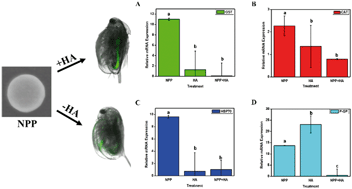Humic acid alleviates the toxicity of polystyrene nanoplastic particles to Daphnia magna†
Abstract
With worldwide environmental accumulation of plastics and their recognized degradation into smaller particles, attention to their impacts on ecological systems and humans has been increasing recently. However, environmental factors and their impacts are seldom considered during their eco-toxicity evaluation. In this study, D. magna neonates were used to assess and compare the acute toxicities of polystyrene microplastic particles (MPPs) and nanoplastic particles (NPPs) in the absence and presence of humic acids (HAs), an important environmental factor in aquatic systems. Four stress response and detoxification genes (CAT, GST, HSP70, and P-GP) were used to characterize the toxic response of the neonates to the exposure. Our results showed that NPPs were much more toxic than MPPs in that 10 mg L−1 NPPs induced over 70% of death in 96 h but MPPs (as high as 400 mg L−1) caused no mortality under all tested conditions. More importantly, we revealed a potent protective role of HA against NPP toxicity at environmentally relevant concentrations. The effect was concentration dependent, as 50 mg L−1 HA subdued the NPP (400 mg L−1) toxicity effect completely. NPPs elicited the up-regulation of all examined genes while HA diminished the change appreciably, further confirming its detoxifying role against NPP toxicity. Through fluorescence and dynamic light scattering measurements, we found that HA was adsorbed on NPPs and formed a corona, without causing agglomeration or precipitation, but changed NPP distribution in the D. magna neonates in a way similar to that of MPPs, leading to alleviated toxicity. Our results suggest that it is essential to consider environmental factors in evaluating and monitoring NPP toxicity as this presents a more relevant exposure state.



 Please wait while we load your content...
Please wait while we load your content...